Meghalaya is the homeland of three ancient hill communities, the Khasi, Jaintias and Garos, and is a land of considerable natural beauty. The important crafts are cane and bamboo works, artistic weaving and woodcarving. Weaving is the traditional occupation of Garo women and is currently pursued by almost every family. The production of cotton textile items is restricted by and large restricted to dakmanda, worn from the waist to a little below the knee. The Garos also weave shirting, bedcovers, bed sheets, and tablecloths. The endi silk produced in Meghalaya is famous for its texture and durability.
The important center for weaving endi silk is Sonidan, a village of about hundred bamboo huts. Besides Sonidan, women in some other villages carry out endi silk weaving. Moreover, the production of jainsen (typical Meghalaya women’s wear) with local mulberry silk has also been introduced. Silk weaving has generally encouraged through training of local weavers in a number of places, production on commercial lines.
Women do weaving in their spare time and use back-strap or loin-looms, the only exception being the garos who also use frame-looms. Endi silk-weaving, famous for its feel and sturdiness, is carried out by the local women.
Pineapple/Sohmarih Fibre Of Meghalaya
Tynrong is the centre for pineapple craft. The craftsmen collect the fibre from the pineapple leaves and design variety of nets. These nets are mainly used to carry fish. Hand bags, belts, purses, mats are the other items made from the fibre
THE TEXTILES USED BY THE VARIOUS COMMUNITIES OF MEGHALAYA
Khasi
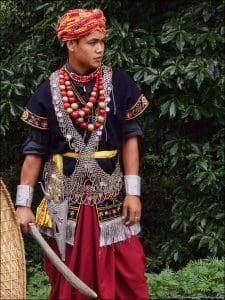
Khasi man can be identified with their unstitched lower garment (dhoti), jacket and turban that he wore. Such attire is seldom used today, except on ceremonial occasions. Their dress has to a large extent been westernized. The women, on the other hand, have retained their traditional dress consisting of an undergarment, and above it, a two-piece cloth pinned on each shoulder (jainsem) and a shawl (tapmoh).
The material mainly comes from the textile mills, for the Khasis have almost lost the art of weaving. Older women continue to wear another wrap of woolen cloth (jainkup) the use of which is fast disappearing. Women wear gold and silver, jewellary usually of very pure form and aesthetically crafted by local smiths.
Khynrium

The women of this community can be distinguished from others by their dress, which is referred to as jainsem. It consists of two unstitched pieces each of to yards, tied at the shoulder. Under it are worn a blouse and a petticoat, depending upon the temperature. On top of the jainsem, is worn the tap-moh khlieh or jain-tapmoh which is a large woolen shawl of bright coloured cheques covering the head as well.
This is knotted at the neck and hangs loose from the shoulders. With the passage of time, the length of jainsem and jainkup has decreased and presently these garments reach above the knee. Traditionally, they use to hang below the ankles. The wrapper or jainkirshah, which was originally meant to cover the head and the shoulders, is now used as a work apron. It is made of a thick cotton cheque cloth.
It is tied on one shoulder thus protecting the jainsem from getting spoiled during work. Another important part of women’s dress is the cotton haversack (pla-kieng), which holds her cash, arecnut, betel leaf, knife and keys of the house. It remains within the folds of her dress. The men, no more wear the jynphong or the sleeveless coat, except during the ceremonial dance, when the silken turban is also worn. They wear shirts and trousers in western styles. The Khynrium are marked out as a tribe that uses gold. The women use gold bracelets (ka khadu kti), gold necklace (u kynjri) with gold balls and coral beads.
Jaintia

The khasi and jaintia male dress is of the same kind. But jaintia women can be distinguished from that of a khasi woman because her dress is somewhat different. An earlier account of a jaintia women’s above the breasts and dropping down to the ankles, while another occasions very handsome and expensive dresses are worn by both men and women.
Women put on earrings and other ornaments of gold and silver. On such festive occasions the women wear a circlet of silver with spearhead ornament in front, rising four or five inches from the forehead.
Garo
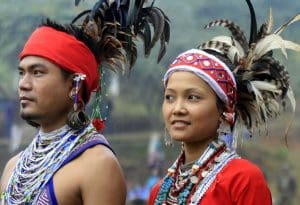
In the interior villages, women still tie a short cloth called eking around the waist and the men wear a loincloth. But in the more accessible areas, the garo women tie a long unstitched piece of cloth called dakmanda around their waist. The dakmanda is hand woven and has a six to ten inch border with a motif or floral designs.
Rabha
The women wear ruphan, an unstitched cloth tied from the waist and the men have taken to wearing modern clothes like trousers. But they can be identified by the gamuchha that they carry, which is a green towel with a design.
Hajong

Women use apiece of cloth, of standard size, with broad and medium borders with a typical colour combination and is known as pathani. The men wear a small piece of cloth as a lower garment, known as gamocha or vija kapod.
Koch

The Koch is a tribe inhabiting the western Garo hills of Meghalaya. The women of this tribe are skilled in the art of weaving and prepare their dresses at home. The women wear a cloth round the waist (lufan), one over the body (kambang) and the men wear, dhoti (unstitched lower garment) and shirt.
Now recently sari, blouse, pant, shirt, coat are now commonly worn by women and men respectively. The traditional dress of the women of this community is called Tintikiya (three piece of cloth) wear one cloth round the waist (lufan) one over the body (kambang), and apiece of cloth on the head (paga).
Mikir

The Mikir of Meghalaya are presently and popularly known as Karbi (brotherhood) or Arlong meaning man. The mikir can be identified by the vertical tattoo marks that they have on the nose, by the pattern on their shawls and their traditional dress. The men wear a dhoti called rikong, an artistic jacket called choi and a turban called poho.
The women wear pini (mekhela), pekok (a cloth that covers the upper portion of the body) and wam kok (which is worn around the around the waist). All these clothes are woven at home. Despite some changes in dress patterns, they have not done away with their traditional dress.
WEAVING IN MEGHALAYA
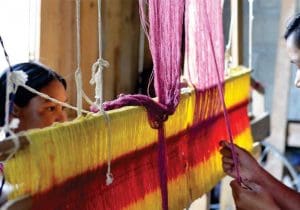
Weaving is an ancient craft of the tribal of Meghalaya. It has a rich variety of hand-woven textiles, with unique characteristics that reflect the state and its skilled artisans. The state produces three varieties of silk – Eri (locally known as ryndia from the castor plants the silkworms feed on), Muga and Mulberry.
Weaving specimens from the various districts of Meghalaya comprise a wide range and number which themselves as pieces of the precious treasures showing in respect of designing and processing, an accomplishment of great measure.

Unlike other parts of India, where much of the spinning and weaving is in the hands of man, spinning and weaving in Meghalaya is the exclusive monopoly of women. Weaving can begin as soon as the first fruit of the new rice have been eaten. The loom used in Meghalaya, is interesting to see working. The loom is simple back strap one with a continuous horizontal warp consisting of six sticks serving the function of warp beam, lease rod, heald stick, beating sword and extra warp beam. For setting the loom, first the warp beam is securely fastened to the wall of the house or any other suitable form supporting in a horizontal position. On this are slipped two loops of bark string.

The loops length of which is adjusted from an already woven piece of cloth, are set at a distance apart equal to a little more than the breadth of the piece of the cloth to be woven. The lower bar or cloth beam is notched at either end so that the weaving belt can be attached to it. This belt is worn by the operator in the small of her back. By it, as she sits on a low bench in front of the loom with her feet pressing on a firm support, she can keep the necessary tension on the warp.

The women keeps the necessary strain by sitting with the belt (Aphi) in the small of her back, attached to a bar from which the warp (kotong) runs to the beam, itself firmly attached either to the well of the house or to stakes fixed in the ground. The heddle, lease rod, and bar above the lease rod, round which the warp is twisted once. The shuttle is shot enough through by hand, and the woof beaten up with wax or with a very fine white powder, found on the underside of the leaves of a species of wild plantation.
The patterns in cloth are obtained by the necessary combination of different coloured threads in the warp and weft. Weaving specimens from the various districts of Meghalaya comprise a wide range and number which themselves as pieces of the precious treasures showing in respect of designing and processing, an accomplishment of great measure. The distinctive costumes and apparels comprise wrappers and shawls, waistcloths and bodice, girdles, scarfs, skirts, aprons and lungis resplendent with skilful colour combination in their own fashion and style.
Spinning and weaving in Meghalaya is the exclusive monopoly of women. Weaving is a full time job for the women particularly; Garo women in Meghalaya. Eri-culture and weaving are also important activities for generating supplementary income and providing a much needed opportunity for women to contribute further to the family, especially for the elderly and the young mothers who are not able to go out to the fields. This traditional knowledge is passed down through generations.
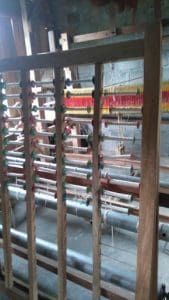
The loom is simple back strap one with a continuous horizontal warp consisting of six sticks serving the function of warp beam, lease rod, heald stick, beating sword and extra warp beam. The loom and its components are hand-made by the village women themselves. The heddles are made from string, tied on manually every time a new warp is put on the loom. The floor loom produces one scarf per warp, whereas the frame loom offers possibilities of increased production.

The distinctive costumes and apparels comprise wrappers and shawls, waistcloths and bodice, girdles, scarfs, skirts, aprons and lungis resplendent with skilful colour combination in their own fashion and style. The patterns in cloth are obtained by the necessary combination of different coloured threads in the warp and weft. The embroidery is traditionally done on a handspun and handwoven eri silk shawl, creating the pattern by counting the warp threads. This embroidery technique is an expression of local cultural identity, and an important physical illustration of historic trading routes in the state of Meghalaya.
EMBROIDERY OF MEGHALAYA

The only known village for Khneng Embroidery, Mustoh village, is located near the Bangladesh border in Shella Bholaganj Block of East Khasi Hills district in Meghalaya, India. It is situated 80km away from the State’s capital, Shillong.
The art of Khneng embroidery can be traced back to around 200 years ago” said Niarit Bliw, though the history is not clear as to how it came to life but all they know is that the embroidery is stitched on the Eri fabric (a silk locally known as jain ryndia) to decorate the border of their traditional garments. Therefore, the genesis of the word ‘Khneng’ (a local Khasi word) basically means ‘border’.
The inspiration for the embroidery comes from a local insect in the surrounding called ‘ktiar’, which resembles a centipede. A single line of a thick band is stitched on one side of the ‘jaiñpïen’ (a wrap-around) vertically. On a shawl, a line of a thicker and thinner band of Khneng embroidery is stitched horizontally. Two lines of embroidery are always stitched together on the shawl.

The fabric which is regularly used as the base cloth for the Khneng is the Eri silk. The Eri fabrics are not locally woven in the village but are bought from another district in Meghalaya, mainly from Ri-Bhoi District which is approximately 134 km from Mustoh village.
Women are the majority of the population that work with Khneng embroidery. The techniques that are used in the art of Khneng embroidery are needles and threads with basic running stitches and with attentive application of the mind, eyes, and hands. One of the most important elements in working with the embroidery is the thread count. The thread count gives evenly distributed motifs on the fabric. They start stitching the motifs form the middle part of the Khneng and work their way from there count by count and part by part.
HANDICRAFTS OF MEGHALAYA
Meghalaya is an abode of wonderful handicrafts. The state is endowed with a rich tradition of art and handicrafts. The people of Meghalaya have long perfected the art of weaving, be it cane or cloth. The markets of the state can be browsed for such amazing handicrafts. The most prominent art here is woodcarving and cane and bamboo work as the state produces abundant wood material. The craftsmen weave amazing cane mats, winnowing fans,caps, umbrellas, stools and baskets. The special kind of cane mat weaved by the Khasis is known as ‘Tlieng’ which is highly durable. They are also known for making domestic knives, utensils and even guns.
Bamboo & Cane Work

Objects made from ‘Tlieng’, a popular variety of cane, are much sought after as it is durable and has an excellent finish. Sleeping mats, baskets, rain shields ‘moorahs’, lamps, side tables, sofa sets, trays, winnowing fans, containers and dried flower arrangements are made with different varieties of Bamboo and cane. Fishing traps are also made from bamboo sticks. The excellent cane bridges traversing fast flowing stream reflect the native craftsman’s skills. Pineapple fiber is used to make fishing nets, bags and purses in the east Khasi Hill villages of Tynrong.
Tribal And Gemstone Jewellery
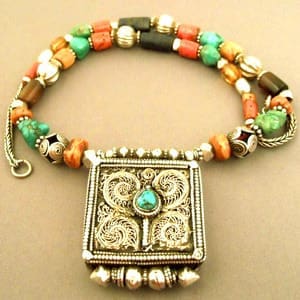
Tribal jewelry and gemstone jewelry of Meghalaya represent an exemplary example of creativity and craftsmanship. Ornaments like ‘Kynjri Ksiar’, ‘Paila’ and ‘Rigitok’ are some of the most famous works of art crafted in the state of Meghalaya. Kynjri Ksiar, made out of 24 karat gold and Paila, a string of thick red coral beads usually worn by the Khasis. Rigitok is a thin fluted stem of glass, strung by a fine thread, which is generally worn by Garo ladies.
Woven Wonders

Clothes for the family, blankets and floor coverings for the house and decorative accessories such as hand bags and wall hangings, waist coats and belts are woven from home- spun cloth across the state in the little villages that dot the hills and valleys. Bedcovers and other house linen items, of fine quality are the expertise of craftsmen from the Garo Hills. Brilliant hues and pretty motifs are used to embellish even the most utilitarian items. You can also pick up some excellent cotton and wool rugs in brilliant hues and fine motifs. Woolen shawls and blankets from the East Khasi and Jaintia Hills are very popular. In Lamatong and Soniden in Ribhoil district, they still use vegetable dyes for their yarns. In western Meghalaya, from the Garo Hills comes the colourful ‘dakmanada’. Soniden is an important silk weaving centre. ‘Endi’ silk, brought from Garo to Palasbari, is reputed for its durability and fine quality. The East Garo Hills, Jaintia Hills and Ribhol are known for their ‘khadi’ material. Fine appliqué work and embroideries are done in Shillong, Tura and Ribhol.
Wood Carving
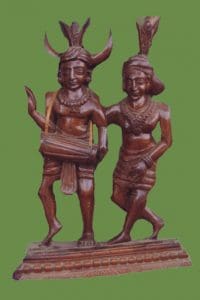
Items both decorative and utilitarian are created from wood with an eye for detail. The subjects are inspired by the bounty of nature and from everyday life. The Garo Hills have a fine tradition for wood carving. Decorative items from the East Khasi Hills are popular souvenir items and are available in the bazaars of Shillong, Meghalaya.
Engravings

some villages of Jaintia and Garo, engravings of the figures of men and animals can be seen on the walls of the house. Another engraving is of Near Jowai which features cravings of a lover and his beloved. These crafts evoke acclaim even in the present day for artistry in designing.
ORNAMENTS WORN BY PEOPLE OF MEGHALAYA

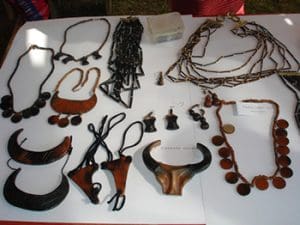
The khasis and jaintias of Meghalaya are fond of Gold jewellery and Coral Bead Necklaces. The thick string of red coral beads worn by them during festive occasions is called the paila while the pendant they wear, called kynjri ksiar, is made of 24-carat gold.
Skillfully crafted ornaments of gold, silver and gilt beads form part of Meghalaya’s rich dancing costumes. The gold beads are hollow spheres filled with lac. Most of these ornaments like amulets, bracelets, necklaces and anklets as well as costumes are decorated exquisitely with diamond like crystal which are manufactured locally. The thin fluted stems of glass strung with fine thread are fancied by the Garo ladies who wear the necklace called the Rigitok.
OFFICIAL TOURISM GOVERNMENT WEBSITE

The Official Website of Meghalaya Tourism
REFERENCES
http://www.thenortheastwindow.com/2017/09/weaving-meghalaya-ancient-craft/
http://www.nesfas.in/traditional-embroidery-technique-meghalaya-khneng/
http://ignca.gov.in/divisionss/janapada-sampada/northeastern-regional-centre/textiles-of-meghalaya/
http://www.superbindiatours.com/handicrafts-of-india/handicrafts-of-meghalaya.aspx


